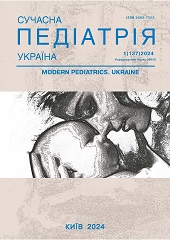The influence of smoking on the cytogenetic status of the oral mucosa in teenagers and young adults
DOI:
https://doi.org/10.15574/SP.2024.137.46Keywords:
smoking, teenagers and young adults, buccal epithelial cells, cytogenetic status, cariological parametersAbstract
Cytogenetic monitoring provides information on both the health status of the population under study and the impact of genotoxic factors, i.e., the cytogenetic status of a person can serve as a biomarker of the level of exposure to genotoxicants, including various types of smoking.
Purpose - to investigate the effect of different types of smoking on the cytogenetic status, namely, to analyse the cariological parameters of buccal epithelial cells of the oral mucosa in teenagers and young adults.
Materials and methods. The cytogenetic status was studied by analysing the karyological parameters of buccal epithelial cells of the oral mucosa in 114 adolescents aged 15 to 24 years, who were divided into groups: the Group I included 26 people who smoke traditional cigarettes; the Group II - 22 people who smoke electronic cigarettes (vapes); the Group III - 23 people who smoke tobacco heating devices (IQOS); the Group IV - 43 people without smoking habits.
Results. A significant increase in epithelial cells of buccal epithelium with nuclear disorders was found in smokers compared to the group of people without smoking habits. In addition, in individuals without smoking habits, no nuclear disorders such as protrusions, proliferation rates, early stage of nucleus destruction and completion of nucleus destruction were detected.
Conclusions. The sensitivity of buccal epithelial cells to the effects of different types of smoking was established, which affects changes in cariological parameters.
The research was carried out in accordance with the principles of the Helsinki Declaration. The study protocol was approved by the Local Ethics Committee of the participating institution. The informed consent of the patient was obtained for conducting the studies.
No conflict of interests was declared by the author.
References
Chaplyak AP, Romanov OP, Nagy BYa. (2018). Problems of tobacco prevention among adolescents. Economics and health law. 2 (8): 142-143.
Dobryanskaya OV. (2018). Smoking e-cigarettes as a risk factor for the health of modern adolescents. Child health. 5 (13): 456-461.
ENSP. (2015). A guide to the treatment of tobacco dependence instead of a guide to smoking cessation. ENSP European Network for Smoking Prevention and Tobacco Use. II edition: 195. URL: http://tobaccocontrol.org.ua/uploads/elfinder/news/ttdg_ua_otto.pdf.
Fedorov SV, Kovalchuk LE. (2015). Cariological parameters of monocytes/macrophages in patients with chronic heart failure. Zaporizhzhya medical journal. 1 (88): 31-33. https://doi.org/10.14739/2310-1210.2015.1.38735
GHO. (2024). Prevalence of tobacco smoking. Global Health Observatory (GHO) data. URL: https://www.who.int/gho/tobacco/use/en/.
Horbas IM. (2011). Risk factors for cardiovascular disease: smoking. Practical angiology. 7-8: 46-47. URL: https://angiology.com.ua/ua/archive/2011/7-8%2846-47%29/article-439/faktori-riziku-sercevo-sudinnih-zahvoryuvan-kurinnya.
Khomyk MI, Kovalchuk LE, Melnychuk GM, Yastrebova OS. (2019). Cariological parameters of buccal epithelial cells of the oral mucosa in healthy and patients with generalised periodontitis. Innovations in dentistry. 1: 7-12.
Korolyova ND, Chorna VV, Humeniuk NI, Angelska VYU, Khlestova SS. (2019). Prevalence of smoking among medical students. Environment and Health. 3: 28-30.
Kovalchuk LE. (2002). Cytochemical aspects of the functional state of the genome and the development of multifactorial diseases. Galician medical bulletin. 9: 4: 33-35.
Krivenko LS, Tishchenko OV, Lepilina KM. (2020). Influence of alternative smoking methods on the features of objective and subjective indicators of oral health. Problems of continuing medical education and science. 2 (38): 20-23. https://doi.org/10.31071/promedosvity2020.02.020
Lisetska IS, Rozhko MM. (2020). Smoking as a risk factor for periodontal tissue diseases. Modern paediatrics. Ukraine. 6: 21-28. https://doi.org/10.15574/SP.2020.110.36
Lisetska IS, Rozhko MM. (2021). Prevalence of smoking habit among adolescents and young adults. Modern paediatrics. Ukraine. 5 (117): 41-46. https://doi.org/10.15574/SP.2021.117.41
Mamеdov FU, Safarov DA, Alekserova SM. (2017). Pathogenetic aspects of the influence of smoking on the condition of organs and tissues of the oral cavity. Bulletin of problems of biology and medicine. 2 (136): 367-372.
Miech R, Johnston L, O’Malley PM, Bachman JG. (2019). Trends in Adolescent Vaping, 2017-2019. N Engl J Med. 381: 1490-1491. https://doi.org/10.1056/NEJMc1910739
PMid:31532955 PMCid:PMC7310772
Neiko EM, Kovalchuk LE, Cherniuk NV. (2007). Epigenetic mechanisms of gene activity regulation and multifactorial diseases. Galician medical bulletin. 14: 1: 11-14.
Picas OB. (2015). Cigarette smoking among the population and its role in the development of diseases. Bulletin of problems of biology and medicine. 1 (126): 48-52.
Pishak VP, Bazhora YI. (2021). Medical Biology: Textbook. 4th ed: Nova Knyha: 608.
Popovych VI, Cherniuk NV, Kovalchuk LE. (2006). Comprehensive assessment of clinical, instrumental and cytogenetic parameters in upper respiratory tract pathology and chronic obstructive pulmonary disease. Rhinology. 1: 3-9.
Ritchie H, Roser M. (2019). Smoking. Our World in Data. URL: https://ourworldindata.org/smoking.
Romanova YUG, Zolotukhina OL. (2018). Influence of exogenous factor - smoking and concomitant pathology of the stomach on the condition of periodontal tissues (literature review). Experimental and clinical dentistry. 1 (2): 14-17. https://doi.org/10.29254/2077-4214-2018-2-144-23-25
Shcherba VV, Lavrin OY. (2016). Smoking: prevalence and effects on organs and tissues of the oral cavity (literature review). Clinical dentistry. 2: 27-33.
World Health Organization. (2018). Oral health. URL: https://www.who.int/news-room/fact-sheets/detail/oral-health.
Downloads
Published
Issue
Section
License
Copyright (c) 2024 Modern pediatrics. Ukraine

This work is licensed under a Creative Commons Attribution-NonCommercial 4.0 International License.
The policy of the Journal “MODERN PEDIATRICS. UKRAINE” is compatible with the vast majority of funders' of open access and self-archiving policies. The journal provides immediate open access route being convinced that everyone – not only scientists - can benefit from research results, and publishes articles exclusively under open access distribution, with a Creative Commons Attribution-Noncommercial 4.0 international license (СС BY-NC).
Authors transfer the copyright to the Journal “MODERN PEDIATRICS. UKRAINE” when the manuscript is accepted for publication. Authors declare that this manuscript has not been published nor is under simultaneous consideration for publication elsewhere. After publication, the articles become freely available on-line to the public.
Readers have the right to use, distribute, and reproduce articles in any medium, provided the articles and the journal are properly cited.
The use of published materials for commercial purposes is strongly prohibited.

